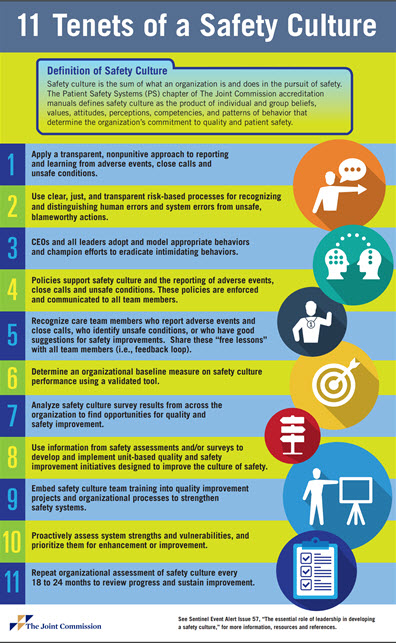Recently, the Joint Commission (TJC) released its recommendations on how to create a culture of safety within healthcare organizations. As hospitals work to create safer environments for their staff and patients, a culture of safety has become tantamount to reaching their operational goals. A culture of safety can have several positive effects at a healthcare facility: safer patients, happier staff, reduced outbreaks of hospital acquired infections (HAIs), and improved employee retention for starters.
TJC included 11 tenets in its recommendations. These 11 steps provide a repeatable framework for hospitals to increase their safety reputation and become “characterized by staff who are productive, engaged, learning, and collaborative.” As TJC puts it:
“Leaders can build safety cultures by readily and willingly participating with care team members in initiatives designed to develop and emulate safety culture characteristics. Effective leaders who deliberately engage in strategies and tactics to strengthen their organization’s safety culture see safety issues as problems with organizational systems, not their employees, and see adverse events and close calls (“near misses”) as providing “information-rich” data for learning and systems improvement. Individuals within the organization respect and are wary of operational hazards, have a collective mindfulness that people and equipment will sometimes fail, defer to expertise rather than hierarchy in decision making, and develop defenses and contingency plans to cope with failures…
In an organization with a strong safety culture, individuals within the organization treat each other and their patients with dignity and respect. The organization is characterized by staff who are productive, engaged, learning, and collaborative. Having care team members who gain joy and meaning through their work has been found to have an important role in establishing and maintaining a safe culture. The Lucien Leape Institute’s Joy & Meaning in Workforce Safety initiative addresses clinician burnout, which is at record highs. Clinician burnout is associated with lower perceptions of patient safety culture and may directly or indirectly affect patient outcomes.”
Read the entire Sentinel Event Alert from the TJC here: The essential role of leadership in developing a safety culture
If your hospital is pursuing higher standards of safety in the workplace, TJC’s 11 tenets provide a great reference point. Your hospital must enable its staff to have input into the ever-changing processes that ensure the highest levels of safety. Not only will this enhance your hospital’s culture of safety, it will also lead to increased employee satisfaction. According to TJC, you must also allow your staff to pursue higher levels of safety through improved tools, organizational processes and safety systems. Consider a system such as iRIScope that helps to improve processes for managing your endoscopes by increasing the transparency of data within your organization. Systems like these show your staff that you are invested in your culture of safety and also arm your staff with the data and analytics to appropriately run their departments.
Summary of the 11 Tenets from TJC:

